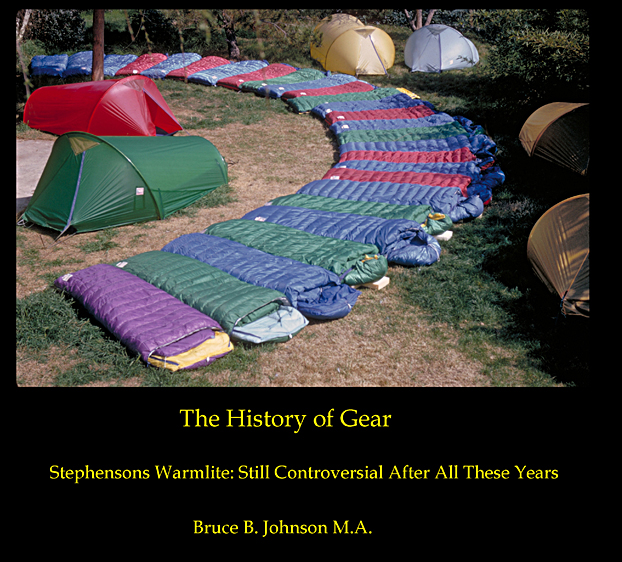 .
. .
.Here's a magnificent feast for any Gear lover's eyes, a true Gear Extravaganza! No fewer than twenty-seven Warmlite Triple Bags all zipped together, plus a selection of Warmlite tents, some Model 2Rs, a 3R, and a 5R off in the shadows (roomy 2, 3 and 5 person tents). You wouldn't think that Jack, the utilitarian aerospace engineer, would go for all these bright colors. Maybe it was the influence of his wife Joan?
The Warmlite Triple Bag has always been one of the company's cornerstone products, and in many ways its most controversial over the years.... It dates from the early 1960s. It features several radical departures from "normal" sleeping bag designs: a vapor-barrier interior is one of the most unique, followed by a "DAM" on the bottom, which is a "down-filled air mattress." The insulation has always been the very finest quality down, often listed as 800 fillpower. Fabrics are ultralight nylons. The "Triple" part of the designation refers to the bags' having two separate zip-on-zip-off tops, giving it an extraordinary range of temperatures, from far sub-zero to mild summers....I owned one of these bags many years ago, and I can testify that the design works well, and especially so in winter snow camping situations.
Please Note: All Material on this page, and in all my "History of Gear" webpages, is copyrighted, and no usage of my material is permitted unless explicit permission is granted by me, Bruce B. Johnson, owner of OregonPhotos.com, contact me at: oldgear@Oregonphotos.com -- Jack Stephenson shared the above image with me in 1995, which I had scanned. The image dates from 1973 or 1974, when Warmlite was still based in the warm, dry climate of California (Woodland Hills).
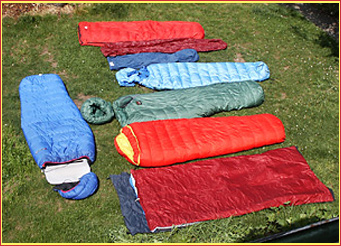
Shown above is this writer's own Gear Extravaganza in 2006. It's a potpourri of design concepts and innovation. The blue bag on the left is a Moonstone Modulus with no down on the bottom, a detachable hood, and a built-on pad (a Thermarest) (link). The red bag on the top is a North Face hoodless ultralight down bag, the North Face Chrysalis (like a Blue Kazoo, but no hood). Next down from the top are two vapor barriers liners, the reddish one made by REI, the dark blue one by Moonstone Mountaineering (a design that comes only up to your armpits). Below that, the light blue bag is a Goretex Zephyr and detached hood by DownHome, part of their MSS (modular sleeping system), of which the next bag down, the green one, is the centerpiece; that green bag with the big detached hood beside it is a DownHome Dipper, in Goretex. ....The brillantly red and yellow bag below that is my Feathered Friends pride and joy, a (non-Goretex) Puffin, for use in temps down to about minus 20 degrees. Below that the big, wide flat bag is a custom sewing creation by myself. It has a Goretex top insulated lightly with a layer of Thinsulate, and a waterproof nylon bottom. I designed it as an overbag with multiple uses, eg. for extreme cold, one slips the Puffin and sleeping pad inside, conservatively taking the Puffin down to minus 40. In very warm weather, it makes a great light bag all by itself for one or two people.
POLITICAL CORRECTNESS: Nudity--- Of course, the classic Warmlite catalogs, especially the "Main" catalog of 1974, have always had detractors due to the use of nude models, both male and female, composed of Jack himself, his wife, his children, his brother and at times even non-related employees or friends.... Recently, one of my contributors contributed this highly tongue-in-cheek re-creation of an old-fashioned Warmlite catalog picture, but this time, it's all "PC" even to sunglasses on the "models" to protect their identities! That's Warmlite's biggest tent, the 5R, a four-season tent for under six pounds, which quite easily sleeps five adults. The "wings" on it are the huge, screened side windows, wonderful for desert camping such as in this Joshua Tree scene in California....Image by contributor Peter Ireland.
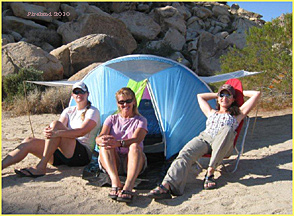
What is the human attraction to, and love of such high-quality backpacking and climbing gear? Somehow the motivations seem different than those of collecting coins or powerful cars... To me, the attraction of such camping gear is primitive, it's the caveman in us, obsessed with shelter, warm furs, and roaring fire to fight the harsh mountain night. It's a hairy, unshaven guy and his mate always thinking winter thoughts in an Ice Age world... The gear is a tool to preserve our lives and our independence under harsh adversity..... I think about the outdoorsman's love of backpacking stoves, and I suspect that there's something strongly connnected to primal FIRE in that love.....For a fascinating, nostalgic look at dozens of vintage camping stoves and lanterns, please see link at page bottom for Monte Dodge's Stoves and Lanterns....
Below is a scanned image provided to me by Jack Stephenson, showing his aluminum-box "Jack Pack," circa late 1950s... Jack, a rather slender man with little natural padding, explained to me that he personally was never tough enough to deal with the unpadded Kelty hip belts of that early era, so invented his own nicely padded hipbelt. Wayne Gregory, famed packmaker, told me that Stephenson's pack design was clearly one of the most intelligent pioneering efforts in hip-carry packs...The packbag shown was an aluminum box (designed to keep out gnawing rodents and also protect contents from the hot sun). It was phased out and replaced by a more conventional nylon packbag around 1962....Meanwhile, Kelty packs did not offer padded hipbelts until 1973-74, and so for an entire generation of backpackers the phrase "Kelty bruises" had a painful meaning (bruising of the hipbones, especially of slim backpackers carrying heavier loads in rough terrain). Another aerospace engineer in Southern California, Andy Drollinger, was offering a superb hip carry system with padded waistbelt by around 1965-- see A16 packs.
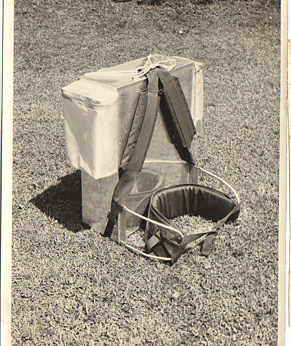
History of Gear miscellaneous discussion: Factors Predicting Success or Failure in a Gear Company
Within the history of many of the classic gear companies one finds trends that tend to predict the ultimate success or failure, survival or extinction of the company.
The founders of the classic companies
fell into some predictable categories-- (1) climbers/backpackers
who tinkered and designed better gear, most without any formal
education for such work; (2) climbers/backpackers who actually
had relevant professional backgrounds, often in some area of engineering
(eg. Jack Stephenson was an aerospace engineer); (3) entrepreneurs
with solid business backgrounds/training who may have had only
a peripheral interest in backpacking/climbing themselves; (4)
the more rare type who combined in one person the above skill
sets...Among the early companies, there are many examples of founders
who were strong in only one area, and that led to a lower chances
of long-term survival..... In Warmlite's case, based upon my contacts
with him, Mr. Stephenson clearly falls into category #2. ..His
company's demonstrated long-term survival and success illustrates
one good solution that I have noted in some of the other classic
companies... Jack writes, "Who are we kidding? She is the
one who really runs the business." He is referring to Warmlite's
very long-term business manager, Jane Fortin....I also give Ms.
Fortin my kudos, based on how nicely my orders for Warmlite gear
were filled back in the 1975-1985 period, when I ordered several
pieces of Warmlite gear.
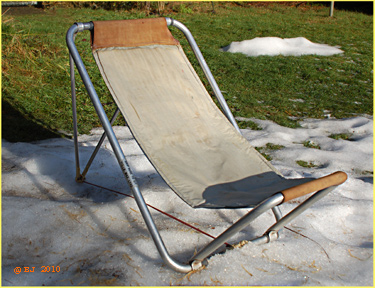
Sling Light Chairs were produced by a friend of Jack Stephenson's in Newport Beach, California ("Freeform R&D").... These 16 oz. aluminum wonders never had a wide distribution. I bought mine directly from the Warmlite catalog about 1976, and it is still fully useable. I added the leather as a cosmetic detail which also strengthened the sitting area. These chairs later became available with headrests and brighter colors, such as a bright red. In the picture of the 5R tent higher on this page, the woman on the right is sitting on a red Sling Light chair with a headrest....The chairs were rated for a maximum load of 215 pounds.
The Sling Light engineering design was wholly consistent with Stephenson's own aeronautical genius. I'm convinced that the chairs should be brought back; they fit perfectly into the booming Ultralight backpacking revolution.
Please Note: All Material on this page, and in all my "History of Gear" webpages, is copyrighted, and no usage of my material is permitted unless explicit permission is granted by me, Bruce B. Johnson, owner of OregonPhotos.com. Contact me at: oldgear@Oregonphotos.com